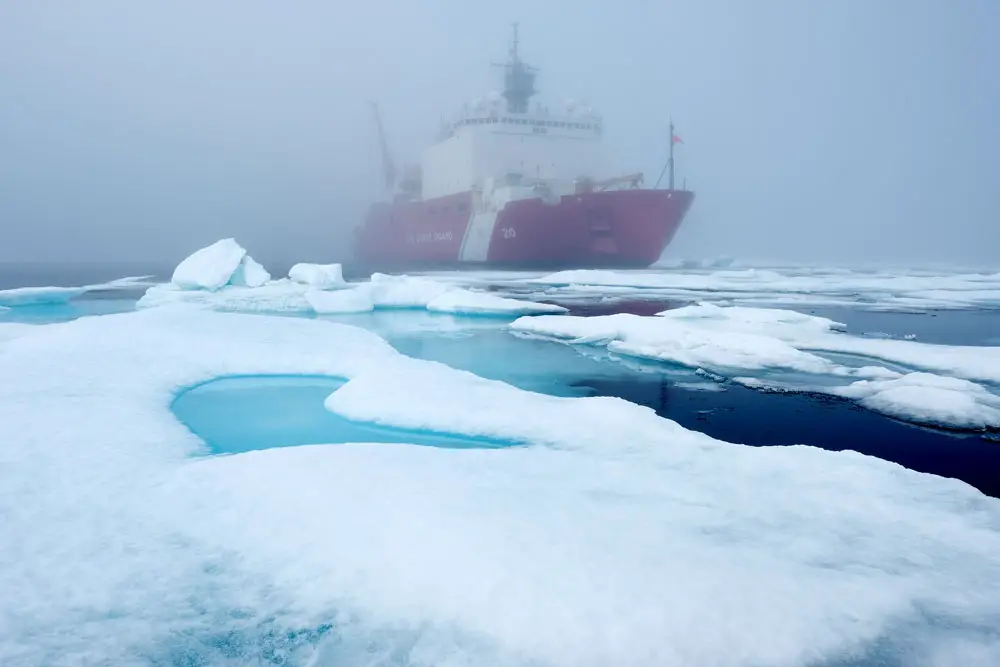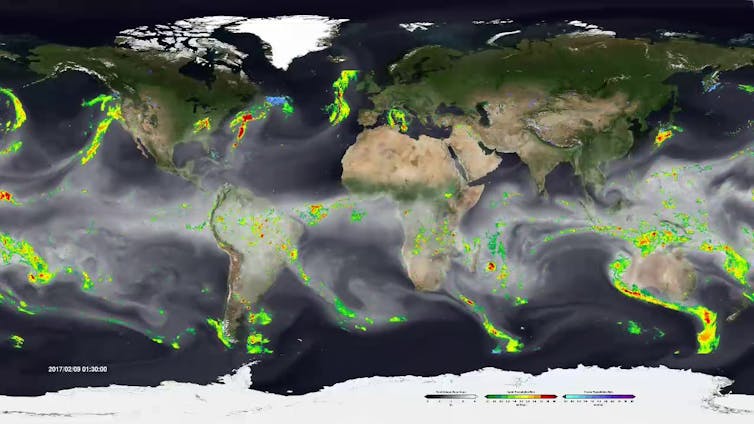
By Pengfei Zhang
Atmospheric rivers, those long, powerful streams of moisture in the sky, are becoming more frequent in the Arctic, and they’re helping to drive dramatic shrinking of the Arctic’s sea ice cover.
While less ice might have some benefits – it would allow more shipping in winter and access to minerals – sea ice loss also contributes to global warming and to extreme storms that cause economic damage well beyond the Arctic.
I’m an atmospheric scientist. In a new study of the Barents-Kara Seas and the neighboring central Arctic, published Feb. 6, 2023, in Nature Climate Change, my colleagues and I found that these storms reached this region more often and were responsible for over a third of the region’s early winter sea ice decline since 1979.
More frequent atmospheric rivers
By early winter, the temperature in most of the Arctic is well below freezing and the days are mostly dark. Sea ice should be growing and spreading over a wider area. Yet the total area with Arctic sea ice has fallen dramatically in recent decades.
Part of the reason is that atmospheric rivers have been penetrating into the region more frequently in recent decades.
Atmospheric rivers get their name because they are essentially long rivers of water vapor in the sky. They carry heat and water from the subtropical oceans into the midlatitudes and beyond. California and New Zealand both saw extreme rainfall from multiple atmospheric rivers in January 2023. These storms also drive the bulk of moisture reaching the Arctic.
Warm air can hold more water vapor. So as the planet and the Arctic warm, atmospheric rivers and other storms carrying lots of moisture can become more common – including in colder regions like the Arctic.
When atmospheric rivers cross over newly formed sea ice, their heat and rainfall can melt the thin, fragile ice cover away. Ice will start to regrow fairly quickly, but episodic atmospheric river penetrations can easily melt it again. The increasing frequency of these storms means it takes longer for stable ice cover to become established.
As a result, sea ice doesn’t spread to the extent that the cold winter temperature normally would allow it to, leaving more ocean water open longer to release heat energy.
How atmospheric rivers melt sea ice
Atmospheric rivers affect sea ice melting in two primary ways.
More precipitation is falling as rain. But a larger influence on ice loss involves water vapor in the atmosphere. As water vapor turns into rainfall, the process releases a lot of heat, which warms the atmosphere. Water vapor also has a greenhouse effect that prevents heat from escaping into space. Together with the effect of clouds, they make the atmosphere much warmer than the sea ice.

NASA/Goddard Space Flight Center Scientific Visualization Studio
Scientists have known for years that heat from strong moisture transports could melt sea ice, but no one knew to what extent. That’s because it’s nearly impossible to install instruments on wild ice to conduct long-term energy exchange observation.
We looked at it in a different way. We were able to establish a statistical linkage between the amount of ice lost and the average count of atmospheric rivers that arrived. In the Barents-Kara Seas and central Arctic, the Arctic quadrant with the most atmospheric river activity, we found that about 34% of the ice decline from 1979 to 2021 can be attributed to the increased frequency of atmospheric rivers.
Other studies have described increases in atmospheric rivers affecting ice loss on Antarctica, Greenland and across the Arctic during the near-record low-ice winter of 2016-2017.

NOAA
Anthropogenic warming – temperature rise caused by human activities such as burning fossil fuels – is a key reason for the increase in atmospheric rivers. We also noticed some influence from natural variability in the tropical Pacific, but studies have found that anthropogenic forcing is likely to overwhelm the influence of natural variability by the middle of the 21st century.
Our earlier research has suggested that after the middle of this century, when temperatures are warmer, just about every part of the polar regions should see a substantial increase in atmospheric rivers.
What sea ice decline means for humans
Like just about everything, sea ice loss has both bad and good effects.
More open water may enable more direct shipping, so ships could sail from Northern Europe to North America and East Asia through the Arctic, which would be much cheaper. It can also increase access to natural resources, including oil, natural gas and minerals crucial for clean energy production.
Of course, atmospheric rivers are also accompanied by strong wind, which can mean more dangerous wind storms for shipping and erosion for coastal areas. For some wildlife, the effects would be a disaster. Polar bears, for example, rely on sea ice to hunt seals. Loss of sea ice also contributes to climate change. Sea ice reflects incoming energy back into space. Without it, the dark oceans absorb more than 90% of that energy, which causes the oceans to heat up, with wide implications.
According to the latest global assessment published by the Intergovernmental Panel on Climate Change, the Arctic could be almost entirely ice-free in summer by the middle of this century. That means thin, fragile ice across almost the entire region in early winter that would be susceptible to increasing storms.
![]()
Pengfei Zhang is Assistant Research Professor of Atmospheric Science at Penn State.





























Timothy Patrick Welch says
The theory of anthropogenic warming may be more influenced by war, wild fires and solar reflectors like roads and the roofs of buildings than by fossil fuels. As the earth is not allowed to absorb the suns energy instead it is reflected back in to the atmosphere. All climates have dry and wet seasons, but further analysis may be warranted. So how about another grant (political slush money).
So the theory goes, that the concrete jungles of large cities may be the major cause of anthropogenic warming.
Timothy Patrick Welch says
The law of conservation of energy states that energy can neither be created nor destroyed, only converted from one form of energy to another…
Since the energy of the sun has been stored as fossil fuels, wood, and uranium the release of that energy may be the main cause of global warming. And a reduction in the ways to sequester the suns energy (think greenery) have been reduced, this further raises the net result.
The release of stored energy coupled with the loss of storage mechanisms may be the main driver of global warming.